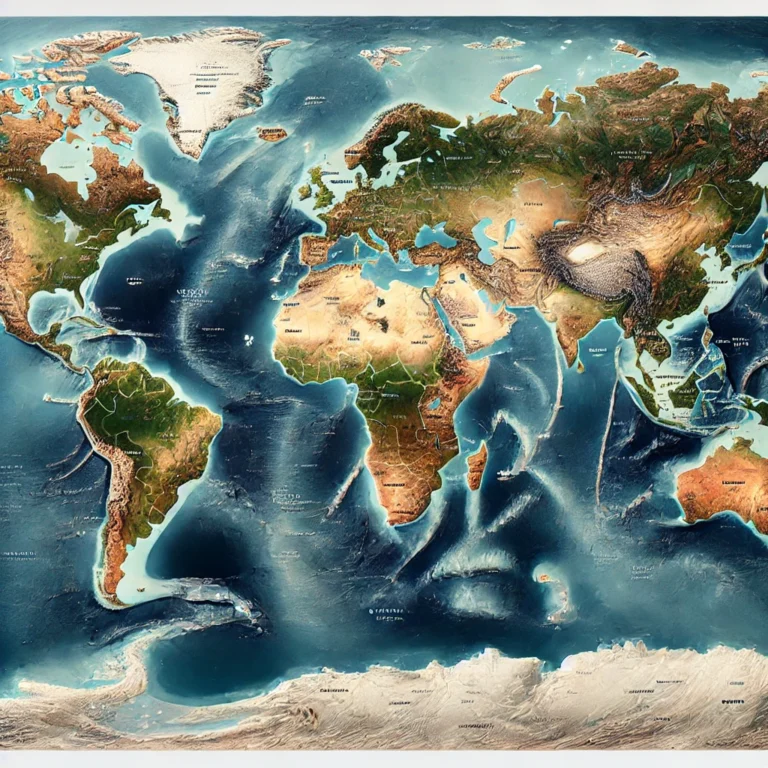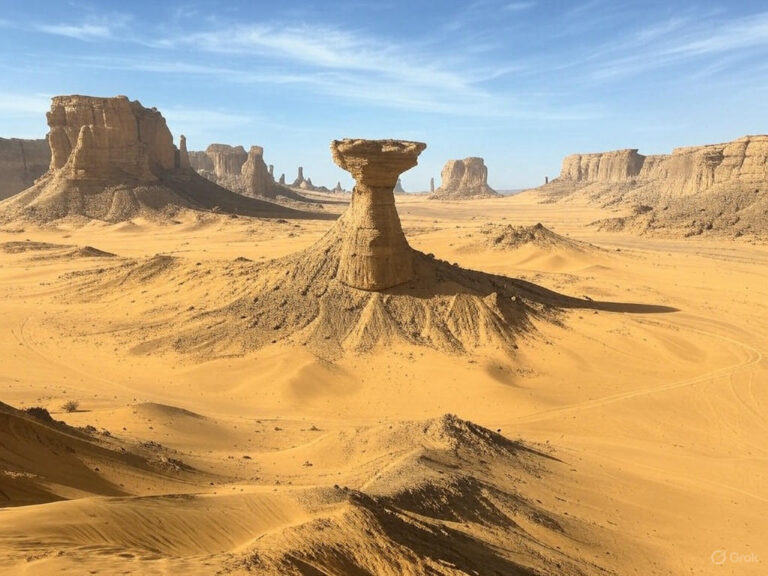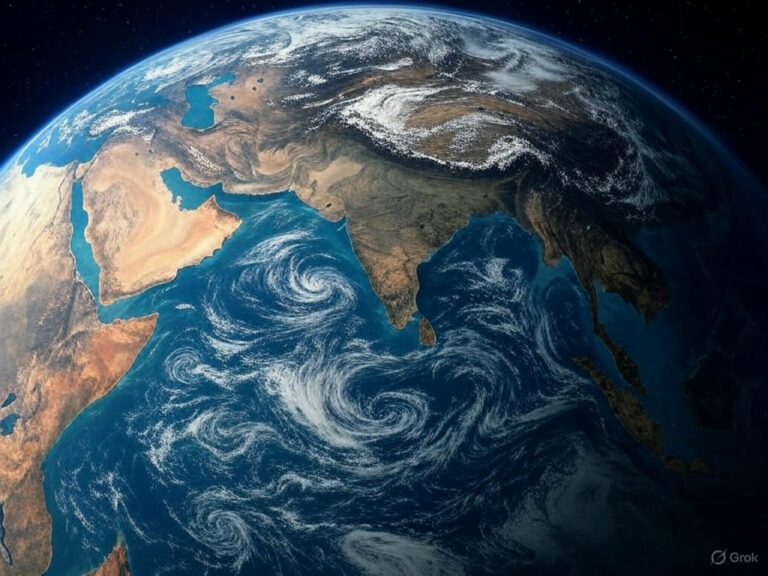Pressure Gradient and Air Circulation
Let’s say you are standing on a vast open field, feeling the gentle breeze against your skin. Have you ever wondered why air moves in a particular direction? Why does wind sometimes blow gently, while at other times it howls with fury? To answer this, let’s understand the pressure gradient, air circulation, and the mysterious force that twists the wind—Coriolis force.
The Pressure Gradient: The Driving Force of Wind
Think of air pressure like water in a tank. If you connect two tanks—one full and one half-empty—water will naturally flow from the fuller tank to the emptier one. Similarly, air moves from areas of high pressure to areas of low pressure. The rate at which this pressure changes over a certain distance is called the pressure gradient.
Now, if you’ve seen a weather map with curved lines called isobars (lines connecting places with equal air pressure), you can estimate wind speed just by looking at how close these lines are:
- Closely spaced isobars → Steep pressure gradient → Stronger winds
- Widely spaced isobars → Gentle pressure gradient → Weaker winds
So, wind ideally moves perpendicular to these isobars, rushing from high to low pressure. But here’s the twist—this movement doesn’t happen in a straight line. Why?

The Coriolis Force: Why Winds Don’t Move Straight
Imagine you’re standing on a spinning merry-go-round and trying to throw a ball straight to your friend on the opposite side. Instead of going straight, the ball curves away. This happens because both you and your friend are in a rotating system. The same thing happens with wind on Earth due to the Coriolis force—a force that bends the movement of air because of Earth’s rotation.
Why Does the Coriolis Force Exist?
The Coriolis force is caused by three main factors:
- The Earth’s spherical shape – Different latitudes have different rotational speeds.
- Earth’s rotation from west to east – As Earth spins, the movement of objects gets deflected.
- Wind speed – Faster-moving winds experience stronger Coriolis effects.
How Coriolis Force Affects Wind Direction
- In the Northern Hemisphere, wind is deflected to the right of its original path.
- In the Southern Hemisphere, wind is deflected to the left of its original path.
- The deflection is always with respect to the wind’s direction of motion.
Now, let’s simply define coriolis force to write in exams:
Coriolis Force is an apparent deflection of moving air masses and ocean currents due to Earth’s rotation, causing them to turn right in the Northern Hemisphere and left in the Southern Hemisphere.
Why Does Coriolis Force Vary by Latitude?
Now, imagine you’re on a rotating disc. The center of the disc (equator) moves slower than the edges (poles). Similarly, Earth’s rotation speed varies:
- At the equator, Earth moves fastest, but winds are parallel to rotation, so Coriolis force is zero.

- At the poles, Earth’s movement is perpendicular to wind flow, creating the strongest Coriolis effect—like a whirlpool pulling objects in.

The formula for Coriolis force is:

- At the equator, θ = 0, so CF = 0 (no deflection).
- At the poles, θ = 90°, so CF is maximum (strongest deflection).
Thus, when winds move from poles to the equator, they lag behind because the equator is moving faster. Conversely, winds moving towards the poles overshoot their destination because the pole moves slower than the wind’s origin.
Key Characteristics of the Coriolis Force
- Always acts at a right angle to the wind’s direction.
- Does not affect wind speed—only its direction. However, increased wind speed makes Coriolis force stronger.
- Strongest at the poles, weakest at the equator.
- Only exists when air is in motion relative to Earth.
Bringing It All Together: The Factors That Control Air Motion
While the pressure gradient force initiates wind movement, the Coriolis force bends its path. But that’s not all—other forces also shape air circulation:
- Frictional Force – Slows down wind near the Earth’s surface.
- Centrifugal Force – Acts on curved winds, pushing them outward.
Together, these forces create the complex global wind patterns we see—like the Trade Winds, Westerlies, and Polar Easterlies—which drive weather and climate across the planet.
Geostrophic Winds
Imagine a tightrope walker balancing between two opposing forces—gravity pulling down and their body adjusting to stay upright. Similarly, in the upper atmosphere, geostrophic winds occur when two forces—pressure gradient force (PGF) and Coriolis force—perfectly balance each other, allowing the wind to move smoothly parallel to the isobars.
How Geostrophic Winds Form?
Let’s visualize a parcel of air at an altitude of about 3 km, where surface friction is negligible. Initially, the air is at rest, but then:
- Pressure Gradient Force (PGF) Sets the Wind in Motion
- Air moves from high pressure to low pressure, just like water flowing downhill due to gravity.
- Coriolis Force Starts Acting
- As soon as the wind begins to move, the Coriolis force kicks in, deflecting it to the right in the Northern Hemisphere (left in the Southern Hemisphere).
- Increasing Speed, Increasing Coriolis Force
- PGF continues to accelerate the wind, but as the wind speed increases, Coriolis force also strengthens.
- This increasing deflection keeps turning the wind further to the right.
- Achieving Balance: Geostrophic Wind
- Eventually, the wind turns completely parallel to the isobars—no longer moving directly from high to low pressure.
- Now, PGF and Coriolis force are perfectly balanced, meaning the wind no longer accelerates or changes direction.
- This balanced wind flow is called a geostrophic wind—an ideal wind that moves without friction in the upper atmosphere.

Key Characteristics of Geostrophic Winds
✅ Occurs at high altitudes (~3 km and above) where surface friction is negligible.
✅ Flows parallel to isobars instead of crossing them.
✅ Balanced forces: PGF pushes air towards low pressure, but Coriolis force counters it.
✅ Speed depends on the pressure gradient: Stronger PGF → Faster winds → Stronger Coriolis force → Quicker equilibrium.
✅ Exists only in free atmosphere (not near the surface where friction disrupts balance).
Ekman Spiral
Imagine standing on a beach and feeling the wind brushing past you. Now, if you were in a hot air balloon, rising higher into the sky, you’d notice something fascinating—the wind direction keeps changing as you go up! This is due to the Ekman Spiral, a phenomenon that explains how friction alters wind movement near the Earth’s surface.
The Role of Friction in Surface Winds
We know that geostrophic winds (which flow parallel to isobars) exist in the upper atmosphere where friction is negligible. However, near the Earth’s surface, friction becomes a crucial factor. Here’s what happens:
- Friction Slows Down Winds
- In the lowest 100 meters, friction with the Earth’s surface slows down moving air.
- The effect is strongest at ground level, where wind speed nearly reaches zero, and gradually decreases with height.
- Reduced Wind Speed Weakens Coriolis Force
- Since Coriolis force depends on wind speed, the reduction in velocity means that Coriolis force weakens as well.
- However, the Pressure Gradient Force (PGF) remains unchanged, which disturbs the balance seen in geostrophic winds.
- Wind Changes Direction Due to Imbalance
- Since PGF is stronger than Coriolis force near the surface, the wind no longer flows parallel to the isobars.
- Instead, it turns slightly towards low pressure, crossing the isobars at an angle.
- Formation of the Ekman Spiral
- As we move higher from the surface, friction weakens, and wind speed increases.
- With increasing wind speed, Coriolis force also strengthens, gradually bending the wind further to the right (in the Northern Hemisphere).
- This results in a spiral pattern in wind direction as we go up—this is called the Ekman Spiral.
- Over the sea, the deflection angle is 10° to 20°, whereas over land (where friction is stronger), it is 25° to 35°.
So, let’s define Ekman Spiral as follows:
The Ekman Spiral is the progressive deflection of ocean currents with depth due to the Coriolis Effect, causing surface water to move at an angle to the wind and deeper layers to rotate in a spiral pattern.
Ekman Spiral and Surface Winds
- Near the surface, winds cross isobars and move towards low pressure areas due to the combined effect of friction, PGF, and Coriolis force.
- This is why cyclonic (low-pressure) winds blow inward and counterclockwise in the Northern Hemisphere, while anticyclonic (high-pressure) winds blow outward and clockwise.
- The effect of friction reduces with height, and at some point (above the friction layer), the wind becomes purely geostrophic again.
Why is the Ekman Spiral Important?
- It explains why surface winds are different from upper-level winds.
- Helps understand ocean currents, which also follow a similar spiral pattern due to wind forcing.
- Plays a role in weather systems, especially the movement of cyclones and anticyclones.
Buys Ballot’s Law: A Simple Rule for Wind and Pressure
Imagine standing outdoors with the wind blowing directly onto your back. Have you ever wondered where the low-pressure and high-pressure zones are located? This is exactly what Buys Ballot’s Law helps us determine!
The Rule of Thumb for Wind Direction and Pressure
Buys Ballot, a Dutch meteorologist, observed a simple pattern in wind movement and pressure systems. The rule states:
- In the Northern Hemisphere, if you stand with your back to the wind,
- Low pressure will always be to your left
- High pressure will be to your right
- In the Southern Hemisphere, the situation is reversed due to the Coriolis force deflecting winds to the left:
- Low pressure is on your right
- High pressure is on your left
Why Does This Happen?
- Wind Moves from High to Low Pressure
- Air always moves from high pressure to low pressure due to the pressure gradient force (PGF).
- Coriolis Force Causes Deflection
- As air moves, the Earth’s rotation (Coriolis force) deflects winds to the right in the Northern Hemisphere and to the left in the Southern Hemisphere.
- Balance Between PGF and Coriolis Force
- In the upper atmosphere, winds align nearly parallel to isobars, forming geostrophic winds.
- Near the Earth’s surface, friction slows the winds, causing them to cross isobars at an angle towards low pressure.
Real-World Application of Buys Ballot’s Law
- Weather Prediction: If you’re outside and can feel the wind direction, you can roughly guess where the nearest low-pressure system (storm) or high-pressure system (clear weather) is located.
- Navigation for Pilots and Sailors: This law helps determine wind patterns, which is essential for sailing and aviation.
- Cyclone Detection: Cyclones form in low-pressure areas, so this law helps in identifying their approximate location.






